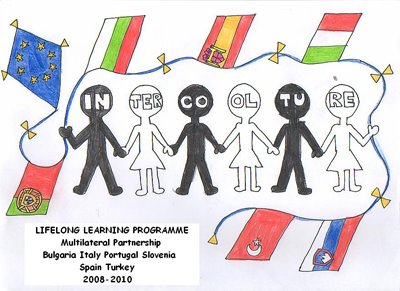Project activities carried out in the course of the school year 2008/2009:
HOW WE INTRODUCED THE TOPIC:
Brainstorming about the topic;
Questionnaires for students (exchange of results)
Logo Competition: Invention of the LOGO of the project
Second step:
MUTUAL KNOWLEDGE:
§ Reciprocal knowledge activities: the students of every partner school introduced themselves, their own town and school and knew their partners through some detailed interviews/questionnaires;
§ Creation and exchange of multimedia products (Power Point) to introduce the partners’ schools/countries/classes/typical days…
§ Start pen friends: correspondence by e-mail and ordinary mail (creation of the classes’ mail boxes)
Third step:
PROJECT ACTIVITIES:
§ Projects meetings: (Italy, Bulgaria and Portugal) to plan/evaluate activities and methodologies, share practices, know the different cultures, compare school systems, monitor the project during all its phases;
§ Elaboration of cross-curricular teaching units in order to involve the teachers of the different areas in the development of the project activities;
§ Articles published on newspapers to spread news about the project
§ Creation of the project weblog to display the results, report on the work, its most important events, its progress….
§ Creation of a notice board about the project inside each school.
§ Collect and exchange: legends/tales (about each country)
§ Carry out some different activities about the legends/tales chosen: drawings, dramas, masks…
§ Exchange of the products obtained
§ Creation of the book: “Old Legends for a New Europe”
§ Final questionnaire for students
Project activities we intend to carry out in the first part of the school year 2009/2010:
§ Prosecution of the school correspondence
§ Involvement of the school staff: monitoring the number of immigrant students in our schools and their origin, and/or the number of emigrant students and their destinations; list and compare the “instruments” each institution has already created to make the integration of the foreign students easier
§ Use of the data collected by the school office staff to share ideas and suggestions about the first layout of a "School protocol". It will give criteria about foreign students’ enrolment and integration, define roles and tasks of all the school staff, the different phases of the students’ welcome at school and propose useful activities about the local language learning;
§ Start planning a language course (by computer) in order to reach two important aims: improve the knowledge of our cultures/languages and lay the foundations of a useful instrument to be used with our foreign students;
§ Plan “listening time activities”: parents/grandparents and/or people coming from other countries tell stories belonging to their own culture; compare, without discriminating, the different values found in the texts/stories read and listened;
§ Plan some teaching units about cinema: significant movies can let our children know each country’s way of living in a more real way and can let them better understand the relationships with others;
§ Study and compare toys and games of the different cultures, find differences and similarities (younger children);
§ Collect and exchange: traditional stories, lullabies, chants and so on (younger children).
HOW WE INTRODUCED THE TOPIC:
Brainstorming about the topic;
Questionnaires for students (exchange of results)
Logo Competition: Invention of the LOGO of the project
Second step:
MUTUAL KNOWLEDGE:
§ Reciprocal knowledge activities: the students of every partner school introduced themselves, their own town and school and knew their partners through some detailed interviews/questionnaires;
§ Creation and exchange of multimedia products (Power Point) to introduce the partners’ schools/countries/classes/typical days…
§ Start pen friends: correspondence by e-mail and ordinary mail (creation of the classes’ mail boxes)
Third step:
PROJECT ACTIVITIES:
§ Projects meetings: (Italy, Bulgaria and Portugal) to plan/evaluate activities and methodologies, share practices, know the different cultures, compare school systems, monitor the project during all its phases;
§ Elaboration of cross-curricular teaching units in order to involve the teachers of the different areas in the development of the project activities;
§ Articles published on newspapers to spread news about the project
§ Creation of the project weblog to display the results, report on the work, its most important events, its progress….
§ Creation of a notice board about the project inside each school.
§ Collect and exchange: legends/tales (about each country)
§ Carry out some different activities about the legends/tales chosen: drawings, dramas, masks…
§ Exchange of the products obtained
§ Creation of the book: “Old Legends for a New Europe”
§ Final questionnaire for students
Project activities we intend to carry out in the first part of the school year 2009/2010:
§ Prosecution of the school correspondence
§ Involvement of the school staff: monitoring the number of immigrant students in our schools and their origin, and/or the number of emigrant students and their destinations; list and compare the “instruments” each institution has already created to make the integration of the foreign students easier
§ Use of the data collected by the school office staff to share ideas and suggestions about the first layout of a "School protocol". It will give criteria about foreign students’ enrolment and integration, define roles and tasks of all the school staff, the different phases of the students’ welcome at school and propose useful activities about the local language learning;
§ Start planning a language course (by computer) in order to reach two important aims: improve the knowledge of our cultures/languages and lay the foundations of a useful instrument to be used with our foreign students;
§ Plan “listening time activities”: parents/grandparents and/or people coming from other countries tell stories belonging to their own culture; compare, without discriminating, the different values found in the texts/stories read and listened;
§ Plan some teaching units about cinema: significant movies can let our children know each country’s way of living in a more real way and can let them better understand the relationships with others;
§ Study and compare toys and games of the different cultures, find differences and similarities (younger children);
§ Collect and exchange: traditional stories, lullabies, chants and so on (younger children).



